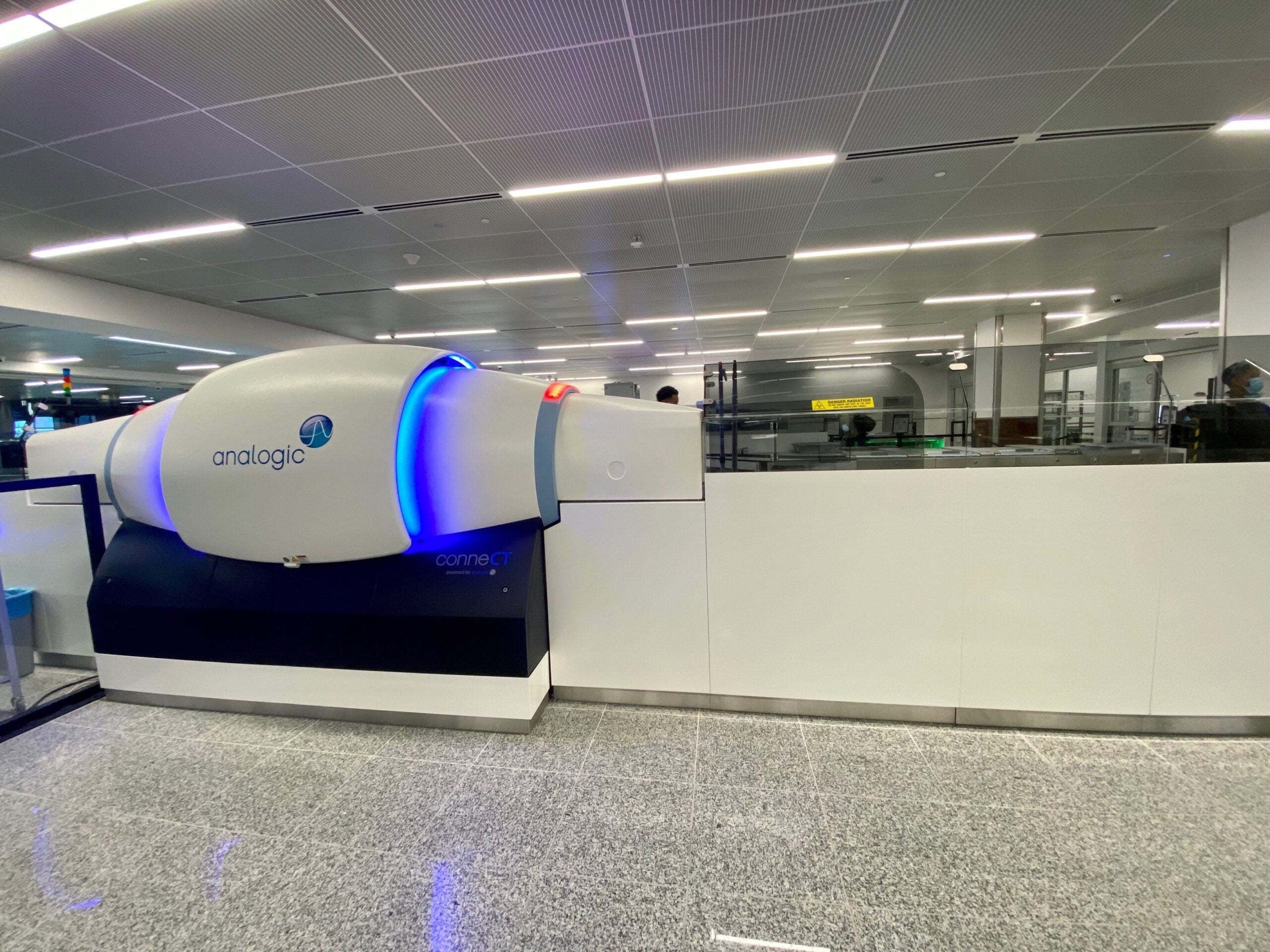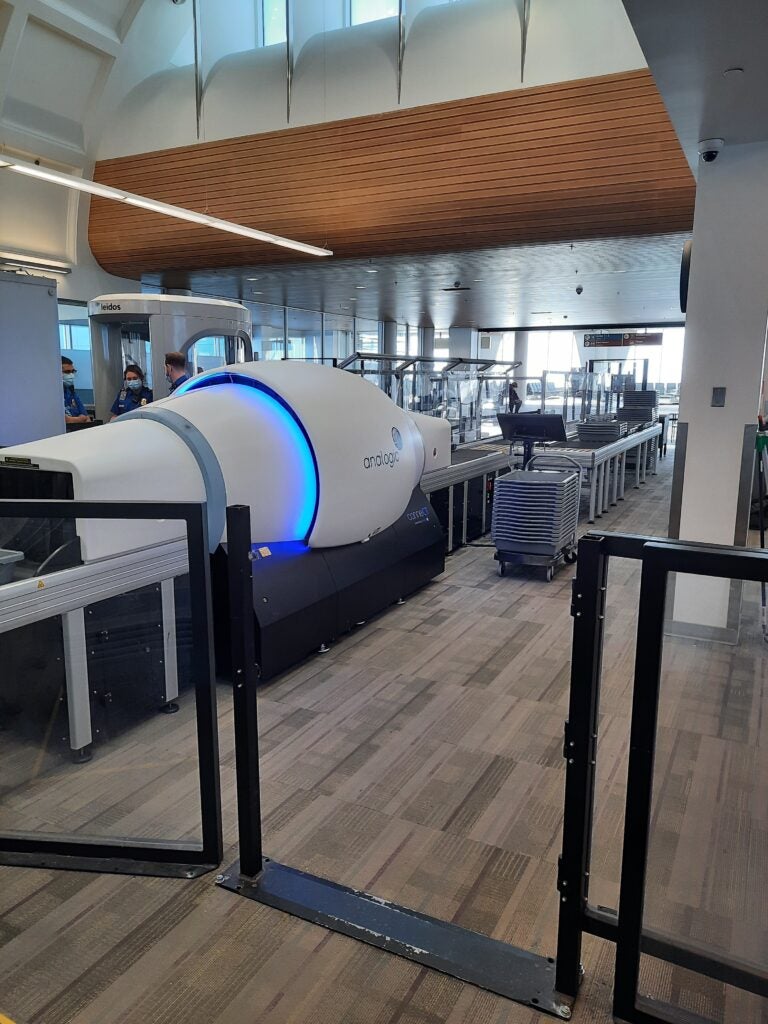
Long, arduous security processes are an unavoidable part of the airport experience, with queues, ID checks, and baggage scanning causing dissatisfaction for 11% of passengers according to the IATA’s ‘Global Passenger Survey 2021’.
Such checks are necessary to maintain the safety of passenger staff. However, even as technology has advanced, offering more convenient and efficient ways to maintain safety, airport security processes have been slow to evolve.

Discover B2B Marketing That Performs
Combine business intelligence and editorial excellence to reach engaged professionals across 36 leading media platforms.
But that is changing, with operators investing in innovative solutions that utilise technologies such as facial recognition, biometrics, and AI to improve efficiency while maintaining the same high security standards.
In March, for instance, the Transportation Security Administration (TSA) announced a $781m order for the procurement and maintenance of Analogic’s Computed Tomography (CT) x-ray systems. The order will see the TSA acquire a total of 938 Analogic ConneCT baggage scanners, which will be deployed at hand luggage checkpoints across the US starting this summer.
Utilising Analogic’s 50 years of experience in CT x-ray scanning, the ConneCT system creates 3D images of carry-on items as they pass through the checkpoint, which security personnel can rotate to analyse for threats.
Combined with advanced threat detection software capable of detecting a wide variety of prohibited items, this system will improve security, efficiency and the passenger experience at TSA checkpoints.

US Tariffs are shifting - will you react or anticipate?
Don’t let policy changes catch you off guard. Stay proactive with real-time data and expert analysis.
By GlobalDataA complete view of passenger hand luggage
Airport security agencies already largely rely on x-ray detectors to see through a bag’s surface and produce a detailed image of its content. However, these detectors are typically fixed, meaning they are only capable of capturing 2D images from a specific angle.
This can make distinguishing between items difficult, particularly if bags contain a variety of electronic devices – which is why passengers are required to remove items such as laptops as they pass through a checkpoint.
CT x-rays – the underlying technology in Analogic’s system – capture a series of images from different angles, which are stitched together to create a 3D image. Airports have been using CT x-rays to scan checked baggage for several years, but these systems were too big to implement at security checkpoints until now.

The streamlined ConneCT scanner – which offers a tunnel size of 62cm x 42cm – has been sized to integrate alongside checkpoint infrastructure such as automated tray return systems.
As an item passes through the ConneCT scanner, detectors rotate around it hundreds of times per minute to produce a high resolution, 3D view. Agents can then rotate the resulting image on three axes to determine whether further checks are required.
An AI assistant for efficient airport security
Often, the ConneCT system – which Analogic says offers the highest level of accuracy and lowest false alarm rate in the industry – will determine whether a threat is present before the manual check takes place. This is thanks to Analogic’s threat detection software, which uses sophisticated algorithms to analyse the shape and material of an item and determine whether it poses a danger.
“First, it can measure how x-rays change velocity and direction as they encounter materials in the item being scanned, which can tell security operators whether an item is composed of a potentially dangerous or benign substance,” Dave Gould, product line manager, Analogic ConneCT, explains.
“Second, it uses computer vision-based AI algorithms to analyse the shapes of items in an x-ray image to determine if a dangerous or prohibited item is present in the bag.”
The system is capable of detecting a wide range of dangerous and prohibited items, including weapons and explosives, to enhance aviation security. The system will provide TSA staff with better visual information to identify threats, resulting in fewer false flags that cost time and divert attention away from other potential threats.
“A key focus of our development efforts is to increase security staff efficiency.”
“A key focus of our development efforts and continual improvement of the ConneCT is to increase security staff efficiency and allow them to focus on where their attention and expertise is needed, rather than, for example, managing delays during the inspection process,” Gould says.
In fact, with ConneCT in place, on-site screening personnel may no longer need to monitor baggage at all. The Analogic system supports remote screening, meaning images can be sent to a centralised screening location to be checked externally, which will “maximise the productivity” of screening staff.
And it will only improve with time. By training the detection algorithm, the system will be able to recognise and alert to new threats as they are identified by Analogic’s airport customers and industry regulators.
Improving the airport passenger experience
The limitations of current airport x-ray systems mean that items such as liquids and laptops must be removed from bags as they pass through a checkpoint.
Despite the necessity, this has a significant negative impact on the passenger experience. According to a past IATA survey, having to remove personal items and large electronics were the two biggest passenger pain points, causing dissatisfaction among 60% and 48% of travellers respectively.
Likewise, according to the most recent ‘Global Passenger Survey’, 41% of passengers identified queuing at security checkpoints as a top priority for improvement.
Once the ConneCT system is in place, passengers passing through US airports will be able to keep such items in their bags due to the clear visuals it provides.
“The limited threat detection capabilities of 2D x-ray systems results in many false alarms.”
As well as greater privacy and convenience, the system will also help to reduce queues and subsequently speed up wait times. Not only will travellers spend less time removing and repacking these items, but fewer false flags mean less chance of getting stopped for a more thorough check.
“We believe that the ConneCT can enable improvements in checkpoint efficiency and passenger experience,” Gould insists. “Today, the limited threat detection capabilities of 2D x-ray systems result in many false alarms, which in turn leads to manual inspections of bags, and ultimately reduced passenger throughput.”
According to Analogic, the ConneCT offers double the processing capacity of traditional airport x-ray systems, allowing up to 600 bags to pass through each scanner every hour. Not only does that benefit passengers, but also airport operators, airlines and retailer partners – Spending less time stuck at security checkpoints, passengers will have more time to make use of duty-free.





